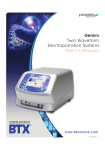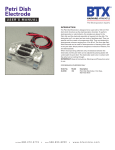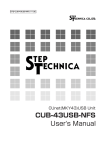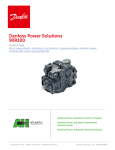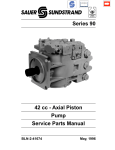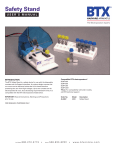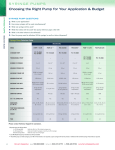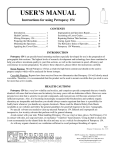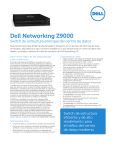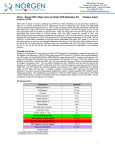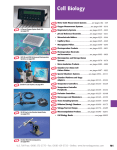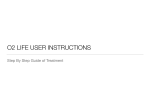Download User`s Manual
Transcript
User’s Manual ECM® 2001 Electrofusion Systems 45-0080 45-0080INT ECM® 2001 Electro Cell Manipulator (100 to 120 VAC) ECM® 2001 Electro Cell Manipulator (200 to 230 VAC) Publication 5501-002-REV-E WEEE/RoHS Compliance Statement EU Directives WEEE and RoHS To Our Valued Customers: We are committed to being a good corporate citizen. As part of that commitment, we strive to maintain an environmentally conscious manufacturing operation. The European Union (EU) has enacted two Directives, the first on product recycling (Waste Electrical and Electronic Equipment, WEEE) and the second limiting the use of certain substances (Restriction on the use of Hazardous Substances, RoHS). Over time, these Directives will be implemented in the national laws of each EU Member State. Once the final national regulations have been put into place, recycling will be offered for our products which are within the scope of the WEEE Directive. Products falling under the scope of the WEEE Directive available for sale after August 13, 2005 will be identified with a “wheelie bin” symbol. Two Categories of products covered by the WEEE Directive are currently exempt from the RoHS Directive – Category 8, medical devices (with the exception of implanted or infected products) and Category 9, monitoring and control instruments. Most of our products fall into either Category 8 or 9 and are currently exempt from the RoHS Directive. We will continue to monitor the application of the RoHS Directive to its products and will comply with any changes as they apply. • Do Not Dispose Product with Municipal Waste • Special Collection/Disposal Required ECM ® 2001 Electrofusion/Electroporation Systems Table of Contents General Information: Serial Number ................................................................2 Calibration ......................................................................2 Warranty ....................................................................2-3 Service ........................................................................3-4 Repair Facilities and Parts ..............................................4 General Safety Summary..............................................5-6 Electrical & Technical Specifications ............................7-8 General Specifications......................................................9 Introduction: Features........................................................................10 Operation: Getting Started ......................................11-12 Quick Start: Front Panel Controls ..............................................13-15 External Connections ..................................................16 Replacing Power Entry Module Fuse............................17 Operating Basics ......................................................18-20 Advanced Operation: Programming Monitoring Connection ..........................................21-22 Experimental Methods..............................................23-28 Appendix A: Troubleshooting ..................................29-34 Appendix B: Glossary of Technical Terms ..............35-38 Appendix C: Accessories and Replacement Parts..39-40 Appendix D: General Cleaning and Maintenance ........40 Appendix E: ECM® 2001 Footswitch Compatibility ......40 Appendix F: Connecting Electrodes ........................41-46 ECM® 2001 Generator Troubleshooting Guidelines ..............................................................47-48 Page 1 www.btxonline.com ECM ® 2001 Electrofusion/Electroporation Systems General Information Serial Number The serial number for the ECM® 2001 is located on the rear of the instrument case. All inquiries concerning these products should refer to the serial numbers on the units. Calibration There is no calibration required for the ECM® 2001. Warranty BTX - Harvard Apparatus warranties the ECM® 2001 for a period of two years from the date of purchase. At its option, BTX – Harvard Apparatus will repair or replace the unit if it is found to be defective as to workmanship or materials. This warranty does not extend to any instrumentation which has been (a) subjected to misuse, neglect, accident or abuse, (b) repaired or altered by anyone other than BTX - HARVARD APPARATUS without BTX - HARVARD APPARATUS’ express and prior approval, (c) used in violation of instructions furnished by BTX - HARVARD APPARATUS. This warranty extends only to the original customer purchaser. Failure to use the Enhancer 3000 High Voltage probe to connect a BTX Generator to an external digital oscilloscope for monitoring will result in voiding your warranty; connecting directly to the external monitoring equipment or modified monitoring setup will damage the Generator. IN NO EVENT SHALL BTX - HARVARD APPARATUS BE LIABLE FOR INCIDENTAL OR CONSEQUENTIAL DAMAGES. Some states do not allow exclusion or limitation of incidental or consequential damages so the above limitation or exclusion may not apply to you. THERE ARE NO IMPLIED WARRANTIES OF MERCHANTABILITY, OR FITNESS FOR A PARTICULAR USE, OR OF ANY OTHER NATURE. Some states do not allow this limitation on an implied warranty, so the above limitation may not apply to you. Without limiting the generality of the foregoing, BTX - HARVARD APPARATUS shall not be liable for any claims of any kind whatsoever, as to the equipment delivered or for non-delivery of equipment, and whether or not based on negligence. Warranty is void if the ECM® 2001 is changed in any way from its original factory design or if repairs are attempted without written authorization by BTX - HARVARD APPARATUS. Warranty is void if parts, connections or cell fusion chambers not manufactured by BTX - HARVARD APPARATUS are used with the ECM® 2001. Page 2 www.btxonline.com ECM ® 2001 Electrofusion/Electroporation Systems General Information (continued) If a defect arises within the warranty period, promptly contact BTX – Harvard Apparatus, 84 October Hill Road, Building 7, Holliston, Massachusetts, USA 01746-1388 using our toll free number 1-800-272-2775 (US Only) or 508-893-8999 (E-mail: [email protected]). Goods will not be accepted for return unless an RMA (Returned Materials Authorization) number has been issued by our customer service department. The customer is responsible for shipping charges. Please allow a reasonable period of time for completion of repairs, replacement and return. If the unit is replaced, the replacement unit is covered only for the remainder of the original warranty period dating from the purchase of the original device. This warranty gives you specific rights, and you may also have other rights, which vary from state to state. Service All service under the warranty will be made at the BTX - HARVARD APPARATUS, Holliston, Massachusetts facilities or an authorized service site. Owner will ship instrument prepaid to Holliston, Massachusetts, USA or the service site. BTX - HARVARD APPARATUS will return the instrument after servicing, freight prepaid to owner’s address. Obtaining Service: Service During Warranty 1. Write or call the BTX - HARVARD APPARATUS Customer Support Group and describe the nature of the problem. 2. Carry out minor adjustments or tests as suggested by BTX - HARVARD APPARATUS. 3. If proper performance is not obtained, BTX - HARVARD APPARATUS will notify you to ship the instrument, prepaid, to its Service Department.The instrument will be repaired and returned at no charge for all customers in the continental United States. Customers outside of the continental United States who have purchased our equipment from distributors should contact the distributor. If you have purchased your equipment from us, you should contact us directly. We will repair at no charge, but will not pay for shipment, documentation, etc. These charges will be billed at cost. Note: Under no condition should the instrument or accessories be returned without prior approval from BTX - HARVARD APPARATUS. An RMA (Returned Materials Authorization) number must be obtained. Page 3 www.btxonline.com ECM ® 2001 Electrofusion/Electroporation Systems General Information (continued) Out-Of-Warranty Service Proceed exactly as for Warranty Service, above. If our Service Department can assist you by phone or correspondence, we will be glad to, at no charge. Repair service will be billed on the basis of labor and materials. A complete statement of time spent and materials used will be supplied. Shipment to BTX - HARVARD APPARATUS should be prepaid. Your bill will include return shipment freight charges. Disassembly by the user is prohibited. Service should only be carried out by experienced BTX - HARVARD APPARATUS technicians. Repair Facilities and Parts BTX - Harvard Apparatus stocks replacement and repair parts. When ordering, please describe parts as completely as possible, preferably using our part numbers. If practical, enclose a sample or drawing. We offer complete reconditioning service. Page 4 www.btxonline.com ECM ® 2001 Electrofusion/Electroporation Systems General Safety Summary Please read the following safety precautions to ensure proper use of your ECM® 2001. To avoid potential hazards and product damage, use these products only as instructed in this manual. If the equipment is used in a manner not specified by the manufacturer, the protection provided by the equipment may be impaired. To Prevent Hazard or Injury OBSERVE ALL TERMINAL RATINGS Review the operating manual to learn the ratings on all connections. GROUND THE ECM ® 2001 This product is grounded through the grounding conductor of the power cord. To avoid electric shock, the grounding conductor must be connected to earth ground. Before making any connections to the input or output terminals of the product, ensure that the product is properly grounded. MAKE PROPER CONNECTIONS Make sure all connections are made properly and securely. DO NOT OPERATE WITHOUT COVERS To avoid electric shock or fire hazard, do not operate these products with the covers removed. AVOID EXPOSED CIRCUITRY Do not touch exposed connections when power is present. DO NOT OPERATE IN LOW IMPEDANCE Sample: Load or Sample If the electroporation samples have an impedance of less than 20 Ω in LV and 40 Ω in HV, the samples may arc and result in sample loss and potential damage to unit. USE PROPER LINE CORD Use only the specified line cord for this product and make sure line cord is certified for country of use. USE PROPER FUSE Use only specified fuses with product. DO NOT OPERATE WITH SUSPECTED FAILURES If damage is suspected on or to the products, do not operate. Contact qualified BTX service personnel to perform inspection. DO NOT OPERATE IN EXPLOSIVE ATMOSPHERE To avoid injury or fire hazard, do not operate these products in an explosive environment. DO NOT OPERATE IN WET/DAMP CONDITIONS To avoid electric shock, do not operate these products in wet or damp conditions. Page 5 www.btxonline.com ECM ® 2001 Electrofusion/Electroporation Systems General Safety Summary (Continued) OBSERVE ALL WARNING LABELS ON PRODUCT Read all labels on the products to ensure proper usage. DO NOT CONTINUALLY PULSE UNIT If you continue to pulse the unit without a 10-20 second delay between pulse series, the unit may overheat and result in damage to components. Safety Terms and Symbols: Terms that appear in this manual: WARNING. Warning statements identify conditions or practices that could result in injury or loss of life. CAUTION. Caution statements identify conditions or practices that could result in damage to these products or other property. Symbols that may appear on the products: Page 6 Danger Attention Protective Functional High Voltage Refer to Manual (Earth) Terminal Ground www.btxonline.com ECM ® 2001 Electrofusion/Electroporation Systems Electrical & Technical Specifications Standard Capabilities: Operating Temperature 10˚ to 40˚C Storage Temperature 10˚ to 50˚C Humidity 90% relative humidity Altitude 2,000 m (operating) Pollution Degree 2 (Not to be operated in conductive pollutants atmosphere) Power Requirements 100 to 120 VAC, 50/60 Hz 200 to 230 VAC, 50/60 Hz Input Power 85 W maximum (idle) 1.6 kW maximum (peak) Fusing T, 8 A, 250 V 5 x 20 mm Mechanical Characteristics: Weight 22 kg (47 lbs) Dimensions, L x W x H 43.2 x 39.4 x 28 cm (17 x 15.5 x 11 in) Electrical Characteristics: Alignment: Frequency 1 MHz, fixed Voltage 0 to 75 VRMS Duration 0 to 99 sec Post-Fusion AC: Frequency 1 MHz, fixed Voltage (VRMS) 1/10 of the alignment AC amplitude, attenuates with time Duration 0 to 9 sec Electroporation: High Voltage Mode (HV Mode): Voltage 10 to 3000 V peak Pulse Length 1 to 99 µsec Low Voltage Mode (LV Mode): Voltage 10 to 500 V peak Pulse Length 1 to 99 msec 0.01 to 0.99 msec Number of Repeats Page 7 0 to 9 www.btxonline.com ECM ® 2001 Electrofusion/Electroporation Systems Electrical & Technical Specifications (continued) Note: LV Mode Less than a 20% V drop at the end of the pulse with the following constraints: PL ≤ 25 ms, load 3 20 Ω PL ≤ 1 sec, load 3 1k Ω PL ≤ 10 sec, load 3 10k Ω HV Mode Less than a 10% V drop at the end of the pulse with the following constraints: PL ≤ 600 µs, load 3 40 Ω BTX instruments are designed for in vitro and in vivo animal and plant applications only and are not for human Clinic. Page 8 www.btxonline.com ECM ® 2001 Electrofusion/Electroporation Systems General Specifications Certifications and Compliances Overvoltage Category: CAT III Products in this Category: Distribution-level mains, fixed installation CAT II: Local-level mains, applications and portable equipment CAT I: Signal levels in special equipment or parts of equipment, telecommunications and electronics Meets requirements of Directive 89/336/EEC for Electromagnetic Compatibility (EC) and Low-Voltage Directive 73/23/EEC for Product Safety. Compliance was demonstrated to the following specifications as listed in the Official Journal of the European Communities: EN 50081-1 Emissions EN 55011 Class B Radiated and Conducted Emissions EN 55082-1 Immunity IEC 10004-2 Electrostatic Discharge Immunity IEC 10004-3 RF Electromagnetic Field Immunity IEC 10004-4 Electrical Fast Transient/Burst Immunity Low Voltage Directive 73/23/EEC EN 61010-1 Safety requirements for electrical equipment for measurement, control and laboratory use. Page 9 www.btxonline.com ECM ® 2001 Electrofusion/Electroporation Systems Introduction The ECM® 2001 is a multifunctional electrofusion and electroporation square wave generator. Embryo and cell fusion are facilitated by the combination of the AC and DC wave pulses. Fusion is achieved by the generation of an AC current wave form that generates a benign dielectrophoretic alignment of cells. With only microsecond switchover time from AC to DC, efficient fusion takes place. After fusion, the AC is reapplied maintaing the cell compression for the rounding off process resulting in a higher number of hybrids. ECM® 2001 features include: • • • • • Page 10 AC waveform of 1 MHz (optimal for fusion) Electroporation capabilities A wide range of voltages from 10 V to 3000 V Finer voltage discrimination Capable of operating at low impedance loads of 20 Ω www.btxonline.com ECM ® 2001 Electrofusion/Electroporation Systems Operation: Getting Started Unpacking The ECM® 2001 Electro Cell Manipulator System is shipped in a carton specifically designed to provide maximum protection for the instrument during transportation under normal handling conditions. Upon receipt, open the carton and carefully remove the ECM® 2001. The contents should be examined for any apparent damage resulting from shipment, and if necessary, BTX - HARVARD APPARATUS should be informed in writing. Be sure to save the carton and packing materials for any future transportation and shipping requirements. Packing Data Check the packing slips to ensure that all items ordered and listed are included in the shipment. If any parts are missing, call BTX - HARVARD APPARATUS at 1-800-272-2775 (US Only) or 508-893-8999, (E-mail: [email protected]) or your distributor. CAUTION Power Source As received the ECM® 2001 is ready for use with either a 100 to 120 VAC, or 200 to 230 VAC, single phase, 50/60 Hz power source according to the electrical requirements of the country to which it is shipped. The power cord has a standard three-prong plug. For safety reasons, it is mandatory that the instrument be grounded. DO NOT MODIFY THE PLUG. Installation Once you have determined that none of the ECM® 2001 components are damaged or missing, proceed with the installation. The location of the ECM® 2001 should be a dry, level surface, free from extremes in ambient temperature, dust, or chemical exposures. Provide a minimum of a 6" space between the back and any obstruction to airflow while a 2” space on both sides of the unit is required for adequate airflow. Unpack cables, chambers and accessories ordered and refer to “OPERATION” for further instructions. Page 11 www.btxonline.com ECM ® 2001 Electrofusion/Electroporation Systems Operation: Getting Started (continued) Location Requirements: • A sturdy, level, clean, non-flammable, dry surface • Adequate power source • Ambient room temperature of 15˚ to 40˚C • Relative humidity of 20 to 80%, non-condensing • A non-explosive atmosphere • Adequate clearance for ventilation Lifting & Carrying Handles are provided at each side of the front panel for lifting and carrying the unit. Page 12 www.btxonline.com ECM ® 2001 Electrofusion/Electroporation Systems Quick Start 1. 2. 13. 3. 6. 5. 7. 4. 8. 9. 10. 11. 12. Front Panel Controls (See Instrument above) # / Name Function 1. SET AC VOLTAGE This knob adjusts the AC alignment voltage from 0 to 75 volts RMS. The voltage is shown on the display to the left of the knob. 2. AC DURATION The thumbpot controls the length of time that the SECONDS alignment is activated during the Automatic Mode. The time is set using the + and - push buttons to select any time up to 99 seconds. 3. POST FUSION AC The thumbpot adjusts the AC duration after the SECONDS fusion pulse in the Automatic Mode. Simply set the pulse length up to 9 seconds for the compression of cells after the fusion. 4. SELECT MODE This knob selects the electroporation mode between the HV mode (10 to 3000 V/ 1 to 99 µsec), LV mode (10 to 500/ 0.01 to 0.99 msec) OR LV mode (50 to 500 / 1 to 99 msec). Once the selection is made, the appropriate light will come on. Page 13 www.btxonline.com ECM ® 2001 Electrofusion/Electroporation Systems Quick Start (Continued) # / Name Function 5. PULSE LENGTH The electroporation/electrofusion pulse length thumbpot controls the pulse length of the squarewave pulse. The pulse is set using the lower (+) and upper (-) push buttons to the “ready” mode. 6. SET VOLTAGE This knob adjusts the pulse voltage. If the generator is in the HV mode, the voltage display (left monitor) is in Volts and it can be set from 10 to 3000 V in the HV Mode and 10 to 500 in the LV Modes. Turn clockwise to increase, counter clockwise to decrease the voltage. 7. NUMBER OF PULSES Set number of pulses from 1 to 9. The + and - push-buttons are used to select the desired number of pulses. The yellow light illuminates when each pulse is delivered to the chamber and a beep is emitted. 8. WAIT This light illuminates when the instrument has reached the end of an operating cycle and discharges all the capacitors for safety. The generator cannot be operated when this light is on. CAUTION: Do not change settings or initiate another cycle until wait light has extinguished. 9. AUTOMATIC START Press and release to initiate an alignment and electroporation cycle according to the preset voltage, pulse length, and number of pulses. 10. REMOTE CONTROL Optional Accessory – Connect the remote control box cable so the generator can be operated from the remote control box. 11. NUMBER OF REPEATS The thumbpot can be used to set the number of repeat cycles. It can be set up to 9 cycles. Page 14 www.btxonline.com ECM ® 2001 Electrofusion/Electroporation Systems Quick Start (Continued) 12. MANUAL START This two-position button allows manual control of the ECM® 2001. Push IN to Start the alignment. The button illuminates and the alignment voltage is applied continuously until the button is pushed a second time to release or a timeout of 99 sec is reached. When released, the green light goes out and the electrofusion pulses are delivered to the chamber. If the timeout is reached, the AC waveform process LED changes from continuously on to flashing. 13. PROCESS LEDS These LEDs illuminate to indicate each stage of the process. Page 15 www.btxonline.com ECM ® 2001 Electrofusion/Electroporation Systems Quick Start (Continued) External Connections: Output Terminals: Type SHV Coaxial Voltage Rating 5000V DC Max Remote Control: Type Mini-Din, 6-pos, Female Pinout Pin Signal 1 2 3 4 5 6 N/C RTN +12V Auto Start Manual Start N/C Output Terminals AC Input and Power Switch Page 16 www.btxonline.com ECM ® 2001 Electrofusion/Electroporation Systems Quick Start (Continued) Replacing Power Entry Module Fuse 1. Turn power switch to the “OFF” position 2. Remove the Power Cable from the wall outlet 3. Remove the Power Cable from the ECM® 2001 4. Remove Fuse Holder Drawer (Refer to illustration) 5. Remove both fuses and perform a visual inspection or a continuity test on each fuse 6. Replace defective fuses with 8 A, 250 V, Time Lag (Slo-Blo) 5 x 20 mm Fuses (Refer to Spare Parts, pg. 38 for ordering information) 7. Install Fuse Holder Drawer (refer to illustration) 8. Install the Power Cable into the ECM® 2001 9. Plug Power Cable into wall outlet 10. Turn power switch to the “ON” position Additional Fusing (Not Operator Replaceable) Fuse Rating Location T 0.1 A 250 V XFMR T1 Secondary 2 T 0.1 A 250 V XFMR T1 Secondary 4 T 1.6 A 250 V XFMR T1 Secondary 1 T 2.0 A 250 V XFMR T1 Secondary 3 T 3.15 A 250 V XFMR T2 Primary 1 T 3.15 A 250 V XFMR T2 Primary 2 T 4 A 250 V XFMR T4 Secondary Page 17 www.btxonline.com ECM ® 2001 Electrofusion/Electroporation Systems Operating Basics Automatic Start Mode Operation 1. Connect Chamber to the input located in the back panel of the ECM® 2001. 2. Plug the ECM® 2001 power cable into correct line voltage outlet. 3. Switch POWER ON in the Back Panel. 4. Set AC Voltage (1) to desired voltage. 5. Set AC Duration Seconds (2) to desired time period. 6. Select between the HV or LV mode (4). 7. Set DC Pulse Length (5). 8. Set DC Voltage (6). 9. Set Number of Pulses (7). 10. Set Post-Fusion AC Seconds (3) to the desired time period. 11. Load BTX Chamber with cell suspension/reagents. 12. Check all settings. 13. Press Automatic Start (9), a beep is emitted and the ECM® 2001 delivers all preset parameters to the Chamber. 14. For electroporation only - set AC Voltage (1), AC Duration (2) and Post Fusion AC (3) to ZERO. Follow all other steps. Manual Start Mode Operation 1. Follow Steps 1to 13 in Automatic Operation 2. Press Manual Start Button (12) (manual start button illuminates and the AC waveform is output). In this mode, the AC Duration is over-ridden and the AC field is on continuously until a 99 sec time out occurs or the button is released. While viewing cells in a microslide under an inverted microscope, the AC Amplitude may be varied to optimize alignment. 3. When cells are aligned appropriately, press Manual Start Button again to release the AC and initiate the set DC parameters. Page 18 www.btxonline.com ECM ® 2001 Electrofusion/Electroporation Systems Operating Basics (Continued) Selection of Operating Mode Automatic Start of the fusion process is initiated by pressing the Automatic Start button (9); in this case, the pre-set AC Voltage and AC Duration is applied. Alignment is followed automatically by electroporation settings of DC PULSE Voltage and Pulse Length. Manual Start (Best with Microslides viewed under a microscope). Push MANUAL START button (12) to turn on the alignment AC voltage. It will illuminate in this position. By pushing it in a second time, the AC alignment voltage is turned off and electroporation pulses are delivered to the test chamber. Alignment Parameters AC Voltage: Dial the voltage setting required using the AC Voltage(1). AC Pulse Length: Dial the AC Pulse Length on thumbpot AC Duration switch (2). Electroporation Parameters Choose between HV or LV Mode (4). Pulse Length: Dial the pulse Length on DC Pulse Length switch (5). DC Voltage: Select the electroporation pulse Voltage by Set Voltage (6). Number of DC Pulses: Set Number of pulses (7). Post Fusion AC Parameters Set the Post Fusion AC (3) time for compression of cells after electrofusion. The post fusion AC amplitude is 1/10 of the alignment AC amplitude. The post fusion AC amplitude attenuates with time. Operation With Microslides & Microscope To connect Microslides to the ECM® 2001 pulse generator, attach Banana-to-Micrograbber Adapters to each HV cable and then connect the micrograbbers to the microslide contacts. It is advisable to tape the cables to the microscope stand to avoid the weight of the cables moving the Microslide. The Microslide wire electrode gap can be filled and emptied with a micropipette tip or a syringe with a hypodermic needle. Page 19 www.btxonline.com ECM ® 2001 Electrofusion/Electroporation Systems Operating Basics (Continued) Operation With Microslides & Microscope (continued) Adjust the AC voltage setting so that cells move slowly toward the Microslide Electrodes. Increase fusion voltage and pulse length in small increments (10%) to get increased fusion yield. Cells will drift apart after alignment if the fusion pulse is absent or too weak. Look for fusion events close to the wires. The electric field is strongest close to the wires and fusion will occur here first. If the field is too strong, the cells will burst (lyse) immediately. If the cells do not move and an increase in voltage leads to boiling of the media, indications are that the cell solution acts too much like an electrolyte. Use fresh mannitol to prepare 0.3 M mannitol (0.2 micron filtered) with a pH of 7.0 to 7.3. Adjust pH with sterile 0.1 N NaOH. Measure pH of mannitol just prior to fusion. Other low molecular weight sugars such as sucrose and glucose have also been used successfully. When operating Microslides under a microscope, it is advantageous to use the generator in the Manual Mode. This way, DC fusion pulses can be initiated as soon as alignment is achieved, thus subjecting the cells to minimal electrical stress. Use a stopwatch to measure the required alignment time. Set the same time or longer in the automatic mode when working with larger chambers. If a demonstration for several people is intended, a microscope with a TV camera attachment and monitor display serves well. Note: The ECM® 2001 Electrofusion Electropation system is NOT compatible with the HT (highthroughput) plate handlers. Page 20 www.btxonline.com ECM ® 2001 Electrofusion/Electroporation Systems Advanced Operation: Programming Important Notices Please refer to the following important notices prior to setting up and using the ECM® 2001. CAUTION Manual Switch Prior to turning on the ECM® 2001, verify that the GREEN manual push button switch is in the "out" or "Off" position, and that it is not pushed in. If the instrument power is turned on and the GREEN manual switch light comes on, turn it off immediately. Only use the manual mode with appropriate buffers under the appropriate conditions for AC alignment optimization. WARNING Procedure WARNING HIGH VOLTAGE: For practical and safety reasons do not touch any of the cables or electrode connections while the ECM® 2001 is in the Manual Start or Automatic Start Modes and the AC field or DC pulses is in use. Check that the unit is not operating and is in standby mode when connecting and disconnecting cables. Page 21 www.btxonline.com ECM ® 2001 Electrofusion/Electroporation Systems Advanced Operation: Programming (continued) Equipment Setup Setup of the ECM® 2001 Independent of Monitoring Please refer to the following diagram for a graphical representation of the set up procedure for using the ECM® 2001: 1. Connect the ECM® 2001 into the appropriate line voltage outlet with the power cable. 2. Connect electrode accessories to the HV output jacks on the rear of the unit using recommended HV cables and adapters (See Appendix A). 3. Proceed to Operation. Page 22 www.btxonline.com ECM ® 2001 Electrofusion/Electroporation Systems Experimental Methods Experimental Methods for Various Fusion Applications The following suggested procedure is a recommendation only and each investigator is encouraged to experiment with alternate cell densities, fusion media and pre and post-fusion procedures, and consult relevant publications. Ohnishi et al (BTX ECM ID# 218) and Ruzin (BTX ECM ID#,183) describe successful protocols for mammalian hybridoma production List of Materials Cells: 1. Myeloma in log phase growth. 2. Spleen, peripheral blood cells, etc. Fusion Solutions Sterile 0.3 M mannitol, glucose or related sugars; 0.1 mM Ca2+ and 0.1 mM Mg2+, pH 7.0 to 7.3 (adjust pH with 0.1 N NaOH.) Fusion Facilitators (elective) Trypsin at a concentration of 5 mg/ml sterile without salt or Pronase at a concentration of 1 mg/ml sterile without salt, or Calmodulin 100 g/ml and Glyceril mono-oleate 50 µg/ml. Equipment & Other Materials 1. RPMI 1640 or DMEM with 10% fetal bovine serum and 2 mM L-glutamine. 2. Trypan blue to determine viability of cells before and after fusion. 3. Sterile 96 microwell plate. 4. Sterile pipette. 5. Microscope with 10x and 40x objective. 6. Optional ice baths for reagents. 7. Laminar flow hood. 8. Table top centrifuge. 9. Sterile conical tubes. 10. Availability of Autoclave. Suggested Pretreatment of Mouse Cells for ECF Spleen cells should be removed from the mouse and teased apart in cold Hank’s Balance Salt Solution (HBSS) or RPMI 1640. Transfer spleen cells to a sterile test tube and allow the large particles to settle. Pipette suspended spleen cells into a new sterile test tube. Remove erythrocytes. Preparations and cell concentrations for human cells and other fusion partners are the same. Page 23 www.btxonline.com ECM ® 2001 Electrofusion/Electroporation Systems Experimental Methods (continued) Fusion Protocol Establishment of optimal fusion parameters may take some time and must be done for each new myeloma/lymphocyte pair. Usually fusion is done at room temperature, but, as an alternative method one might elect to keep cell suspension on ice during processing. Additionally, one might decide to place fusion chambers in an ice bath during the actual fusion process. Immediately prior to fusion, the cells must be concentrated and washed in a nonelectrolyte solution. Fusion In Standard 0.3 M Mannitol The two cell lines are combined at a 1 to 4 myeloma/lymphocyte ratio and the mixture is centrifuged at 1,000 rpm for 6 minutes, to obtain a cell pellet. The supernatant is withdrawn and sterile 0.3 M mannitol with a pH between 7 to 7.3 is added. The cells are washed two times in 0.3 M mannitol and resuspended to a final concentration of 2 x 106 cells per ml for fusion. Cells in 0.3 M mannitol should not be allowed to remain in solution for more than 2 hours. Therefore, during the course of the experiment it may be necessary to prepare several cell pellets. Fusion In Glucose As an alternative to standard 0.3 M mannitol, one may elect to use other non-electrolytic buffers such as 0.3 M glucose at a pH of 7 to 7.3 for fusion. In this case one simply substitutes the sugar (or other substance) for the mannitol with the exception that the cells may be kept in the glucose for up to 4 hours. Fusion Facilitators (elective) One might add pronase or trypsin to remove some of the membrane surface proteins and to neutralize possible surface electric charges. This is advisable if cells are difficult to fuse. Post-Fusion Protocol for Standard 0.3 M Mannitol, Glucose & Related Sugars 1. Following the fusion process, remove cell suspension under sterile conditions from the fusion chamber and carefully pipette into a sterile test tube. Add 10 ml of RPMI 1640 or DMEM with 10% fetal bovine serum and 2 mM L-glutamine. Allow to rest for 15 minutes. 2. Centrifuge cells at 500 rpm for 5 minutes and remove supernatant. Carefully resuspend cells in culture medium and pipette cells into a 96 microwell plate at a concentration of 2 x 105 cells per well (0.2 ml per well). Check wells for sufficient amount of medium. 3. Incubate cells at 37ºC with 5% CO2 overnight. Page 24 www.btxonline.com ECM ® 2001 Electrofusion/Electroporation Systems Experimental Methods (continued) 4. The following day, remove one-half of the medium and re-feed cells with HAT medium. On days 4, 7, and 10, again remove one-half of the medium and re-feed with HAT. Cells may be supplemented with feeder layers or other growth factors. 5. Check cultures daily for HAT medium selection. Once colony formation is observed, begin feeding with HAT medium at first phase of expansion. Plant Protoplast Fusion The following protocol is intended only as a guide to researchers involved in the genetic engineering of plant protoplasts. Basic Procedure 1. Obtain freshly isolated protoplasts as per usual methods. (Note: Fusion will not be successful after cell wall regeneration has occurred.) 2. Gently pellet in non-electrolytic solution. 3. Remove supernatant and resuspend in non-electrolytic solution, adjusting the density to 1.5 to 6 x 105 protoplasts/ml according to size. 4. Proceed with electrofusion. Solutions In general, optimal viability will occur when non-electrolytic solutions are most consistent with pre-fusion solutions in terms of osmotic potential, pH, and composition. 1. Non-electrolytic sugars such as mannitol, glucose, sorbitol, etc. are recommended. 2. Low-salt concentrations of CaCl2 (140 M) and Hepes (600 M) are optional, and, over a limited time, do not appear to be detrimental. 3. pH settings can be explored for each protoplast type. Fusions have been most successful at pH values of 7.0 to 7.5. 4. Osmotic potential should be equal to the protoplast isolation solution. 5. Recalcitrant protoplasts have been successfully fused by the addition of two drops (per ml) of trypsin (Sigma Typ XIII PCK treated, 5 mg/ml). Other facilitators such as pronase, dispase, DMSO, PEG, etc. should also be investigated. Page 25 www.btxonline.com ECM ® 2001 Electrofusion/Electroporation Systems Experimental Methods (continued) Instrument Settings Typical fusion yields should average approximately 20% with the addition of protease, and 7% without. PEG treated cells fuse typically at a 1% yield. 1. Addition of more than 1 or 2 pulses appears to damage protoplasts without increasing yield. 2. Typical settings for the Microslide might be as follows: Amplitude/Voltage 035 V Time/Pulse Width 25 sec DC FUSION 260 V 40 µsec Yeild: Total Fusions 8.6% Heterokaryons 2.6% AC ALIGNMENT Nuclear Transfer/Cloning The following protocol is intended only as a guide to researchers involved in nuclear transfer/cloning applications. This protocol was adapted from Meng et al, 1977 (BTX ID#3588) ElectroSquarePorator™ T820 ELECTROFUSION PROTOCOL CELLS: rhesus monkey oocyte Ce l l P re pa r a t i o n 1. Prepare enucleated recipient oocyte and donor blastomere as indicated in the paper. 2. Prepare monolayer culture with buffalo liver cells (BRL 1442), CMRL-1066, and 10% neonatal calf serum. Maintain monolayer culture at 60% confluency during coculture, and change medium every 24 hours. Electroporation Settings Choose Mode HV (99msec/3 kV) Set Voltage 130 to 140 V Set Pulse Length 50 msec Set Number of Pulses 2 pulses Chamber BTX microslide P/N 450 (0.5 mm gap) Desired Field Strength 2.6 to 2.8 kV/cm Page 26 www.btxonline.com ECM ® 2001 Electrofusion/Electroporation Systems Experimental Methods (continued) Electroporation Procedure 1. Aspirate an individual blastomere into a microinjection pipette and place under the zona pelucida of an enucleated oocyte or zygote. 2. Culture in KSOM with 10% NCS. 3. Expose oocyte pairs to KSOM containing cycloheximide (7.5 mg/ml), cytochalasin B (7.5 mg/ml), and 10% NCS for 1 hour to induce ooplast activation. Then place them individually in an electric field. 4. Induce membrane fusion by 2 continuous square wave DC electrical pulses in 0.3 mannitol, 100 mM CaCl2, 100 mM MgSO4, and 0.5 mg/ml polyvinylpyrrolidone (with the aid of a pipette controlled by a micromanipulator or just manually by hand). 5. Oocyte pairs receive 2nd and 3rd pulses at hourly intervals. Between pulses, hold the pairs in KSOM, cytochalasin B, and cycloheximide. 6. Reconstituted embryos are subsequently cocultured on a BRL cell monolayer. Results 3 biochemical pregnancies resulted with one lost at 30 days of gestation. The other two culminated in the births of one male and one female monkey. Genetic typing indicated that the putative sire (sperm donor) and the putative mother (female from which the nucleus was harvested) were the true biological parents of both nuclear transfer infants. Reference: Meng et al, Rhesus Monkeys Produced by Nuclear Transfer, Biology of Reproduction, 57, 454-459, 1997 ( DB # 3588) Step-By-Step Procedures To Optimize Yield of Fusion Products After preparing the cell lines for fusion as described above, the following procedures will aid in the determination of optimum instrument settings. This is important if new cell lines are to be fused for which no previous experimental data is available. • Determine instrument setting with Microslide • Set both AC Voltage (1) and DC Voltage (6) to zero. • Set AC (2) and DC (5) time periods to zero. • Fill wire gap with cell suspension. • Increase the AC voltage to 10 V. Page 27 www.btxonline.com ECM ® 2001 Electrofusion/Electroporation Systems Experimental Methods (continued) • Push Manual Start button (12) and observe cells for 30 seconds. If no movement occurs, increase AC Voltage by increments of 10 V until movement is observed. • Change cell suspension between experiments, if heating or drying is observed. • Turn off the alignment signal if cell suspension is changed, by pushing Manual Start (12) button (99 second limit) a second time. Signal is on as long as the AC waveform process LED is on continuously (not flashing). • Experiment with AC Voltage and time period until a good percentage of the cells gently form dimers (doublets) within 10 to 20 seconds. Note settings. • Set AC time period to the value found good for alignment. • Set the Post Fusion AC (3) time period up to 9 seconds to compress the cells after electrofusion. • Optimize system parameters with respect to cell viability. Use the basic settings that were derived earlier and make several runs with modified settings. Cultivate cells for 4 days from each run in RPMI 1640 or DMEM, 10% fetal bovine serum, hypoxanthine and thymidine 2 mM L-glutamine and test part of the cell culture each day for viability by trypan blue exclusion. Choose settings which lead to highest viability after 4 days. • System parameters which should be investigated for cell viability are as follows: Vary Alignment Voltage and duration in steps of 20% Higher voltage requires shorter duration. • Vary DC Voltage and Pulse Length in steps of 20%. • Experiment with Post Fusion AC duration to hold cells together after fusion. Troubleshooting For trouble shooting refer to Appendix A: • Cells Don’t Align • Cells Don’t Fuse • Cells Don’t Divide • Cells Don’t Secrete Antibody Page 28 www.btxonline.com ECM ® 2001 Electrofusion/Electroporation Systems Appendix A: Troubleshooting Cells Do Not Align Make sure the Microslide is clean (free of cell debris) START Try varying the voltage while observing the cells on the Microslide under microscope. YES Alignment YES Alignment YES Alignment YES Alignment YES Alignment YES Alignment NO Make sure the equipment is set up right. All cables should be connected. NO Check the pH of the cell suspension. It should be between 7 to 7.3. Adjust with 0.1 N NaOH. If too much of NaOH is added this produces a basic condition and produces undesired electrical field. NO Are cells alive and in logarithmic growth phase? If not change cells. NO Make sure that the microscope is focused on cells between wires. Adjust accordingly. NO Increase the cell concentration if the cells move but do not align. NO Call BTX - HARVARD APPARATUS at 1-800-272-2775 or 508-893-8999 (E-mail: [email protected]) or your distributor. Page 29 www.btxonline.com ECM ® 2001 Electrofusion/Electroporation Systems Appendix A: Troubleshooting (Continued) Cells Do Not Fuse Observe the microslide under microscope. Fusion is successful if cell pairs do not drift apart after the fusion pulse and when they round off slowly. START Did you set up the instrument right? YES Fusion YES Fusion YES Fusion YES Fusion YES Fusion YES Fusion NO Check cable connection to microslide and verify continuity e.g. with an ohmmeter. NO Increase fusion pulse amplitude and pulse length. Cells will lyse at a critical upper setting. Stay below this setting. NO Do cells rotate? If yes change the alignment amplitude/alignment time. NO Check pH of cell solution: adjust to 7 to 7.3 using 0.1 N NaOH. Were cells in fusion solution for extended period of time? If yes, use fresh cells in solution. NO Add one drop of 1 mg/ml pronase or one drop of 5 mg/ml trypsin to the cell suspension about to be fused (30 sec. before fusion). NO GO TO THE NEXT PAGE Page 30 www.btxonline.com ECM ® 2001 Electrofusion/Electroporation Systems Appendix A: Troubleshooting (Continued) Cells Do Not Fuse (continued) Apply post fusion confinement force. Observe if cells start to round off. Did you set up the instrument right? YES Fusion YES Fusion NO Change pre fusion treatment: were cells exposed to hypertonic solution. NO Call BTX - HARVARD APPARATUS at 1-800-272-2775 or 508-893-8999 (E-mail: [email protected]) or your distributor. Page 31 www.btxonline.com ECM ® 2001 Electrofusion/Electroporation Systems Appendix A: Troubleshooting (Continued) Cells Do Not Divide START Reduce the instrument settings for alignment amplitude and duration, also the electroporation DC pulse amplitude and pulse length. Verify cell viability using trypan blue. YES Division YES Division YES Division NO Reduce pronase/trypsin concentration and/or treatment time of cells. NO Post fusion care is critical for cell division. Verify procedure. NO Call BTX - HARVARD APPARATUS at 1-800-272-2775 or 508-893-8999 (E-mail: [email protected]) or your distributor. Page 32 www.btxonline.com ECM ® 2001 Electrofusion/Electroporation Systems Appendix A: Troubleshooting (Continued) Cells Do Not Secrete Antibody (Ab) START Reduce instrument settings for alignment amplitude and also the fusion amplitude. Verify cell viability using trypan blue. YES Ab Secretion YES Ab Secretion YES Ab Secretion YES Ab Secretion YES Ab Secretion YES Ab Secretion NO Reduce pronase/trypsin concentration and/or treatment time of cells. NO Immunization protocol might have been ineffective i.e. was animal hyperimmunized? Change immunization. NO Were myeloma cells in log growth phase? If no, repeat experiment with myeloma cells in log growth phase. NO Is post fusion care proper? Verify post fusion protocol. NO Genetic makeup of hybrid could be incomplete. NO Call BTX - HARVARD APPARATUS at 1-800-272-2775 or 508-893-8999 (E-mail: [email protected]) or your distributor. Page 33 www.btxonline.com ECM ® 2001 Electrofusion/Electroporation Systems Appendix A: Troubleshooting (Continued) Generator Test # Generator Test 1. Make sure the power cord is connected to the ECM® 2001, and it is plugged in. 2. Turn on the power. Do the displays illuminate? 3. Set the AC Voltage Setting (1) and DC Voltage Setting (6) to Zero. Do the monitors display Zero? 4. Set Select Mode Knob (4) to the HV mode 1 to 99 µsec. Does the HV Mode green light illuminate? 5. Set Select Mode Knob (4) to the LV Mode 0.01 to 0.99 msec. Does the LV Mode green light illuminate? 6. Set Select Mode Knob (4) to the LV Mode 1 to 99 msec. Does the LV Mode green light illuminate? 7. Push in the Manual Start button. Does the manual start button light illuminate? 8. Push in the Manual Start button again. Does the manual start button light extinguish? 9. Set the following parameters on the instrument • Set the AC Voltage (1) setting to 30 V. • Set the AC Durations (2) to 3 seconds. • Set the Post Fusion (3) to 3 seconds. • Set the Select Mode Knob (4) to HV Mode 1 to 99 usec. • Set the Pulse Length (5) to 40. • Set the DC Set Voltage (6) to 50 volts. • Set the Number of Pulses (7) to 2. • Press the Automatic Start (9) button and release. Yes No Do the process LEDs (14) illuminate? Please contact BTX - HARVARD APPARATUS Technical Services at (800) 272-2775 or (508) 893-8999 E-mail: [email protected] if you answered “no” to any of the questions above. Page 34 www.btxonline.com ECM ® 2001 Electrofusion/Electroporation Systems Appendix B: Glossary of Technical Terms Alignment A consequence of cells being exposed to an inhomogeneous or divergent electric field, resulting in their movement toward the electrodes, and subsequent alignment or pearl chain formation. Alternating Current (AC) During electro cell fusion, an alternating electrical current is utilized to induce an inhomogeneous, or divergent electric field, allowing for dielectrophoresis and pearl chain formation. The resulting physical contact between cells facilitates the fusion process that may result following the application of a DC electroporation pulse. Capacitor Alternating Current (AC) A device that stores energy in the form of an electric field. A capacitor consists of two metal plates insulated from each other by a dielectric (insulating, usually a plastic material such as Mylar) material. In an ideal capacitor, no conduction current flows between the plates after the capacitor is completely charged. Capacitors can be fixed, variable, or adjustable. Chambers Electroporation and Electrofusion Chambers are the devices used to contain the cells/molecules to be fused/transfected. The chambers include the electrodes through which the ECM® 2001 pulse generator delivers the electric field to the cells. Fusion Chambers include the Microslides (Model 450, 450-1, 453, 453-10), Meander Fusion Chamber Model 454, and the Flat Electrode Model 484. Cloning In terms of applications for electro cell fusion, cloning refers to the ability to generate identical, viable animals, through processes such as nuclear transplantation. Disposable Electroporation Cuvettes Plus™ Compression See Alignment, Dielectrophoresis, and Pearl Chains. The result of an AC alignment. Dielectric Breakdown The reversible breakdown of bi-lipid layer membranes as a result of the application of a DC electroporation pulse. A sufficiently high field strength may increase the membrane potential past a critical point leading to the breakdown of the membrane. Dielectric Constant For a given dielectric (nonmetallic) material, the ratio of electrical capacitance of a dielectric- filled capacitor to a vacuum capacitor of identical dimensions. Page 35 www.btxonline.com ECM ® 2001 Electrofusion/Electroporation Systems Appendix B: Glossary of Technical Terms (continued) Dimer Formation The bringing together of two cells, through the process of dielectrophoresis, so that they may be fused, resulting in a hybrid. Refer also to Pearl Chain. Dimer Formation Direct Current (DC) During electro cell fusion, a direct current is utilized to produce a high intensity, short duration electric field, causing a reversible physical breakdown of bi-lipid membranes and resulting in the formation of temporary pores. When juxtaposed pores in the membranes of two or more cells reseal following the DC pulse, cells may become fused.See Electric Field. Direct Current (DC) Frequency The number of times an oscillation goes through a complete cycle in one second. The unit is either cycle/sec or Hertz (Hz). Homogenous Electric Field An electric field where the direction and strength of the field lines are constant. Divergence The deviation of field lines (e.g. electric field lines) from parallel, homogeneous conditions. A highly divergent field is a very inhomogeneous field where the value and direction of the field change drastically in the area under consideration. Electric Field/Electric Field Strength The potential difference between two points (electrodes) (in Volts) divided by the distance between the electrodes (called gap, and expressed in cm). Expressed as V/cm or kV/cm. This is true only if the electric field is homogenous as it is in parallel plate electrodes. Electric Field Force The force acting on any charge in an electric field. The force is equal to the product of the charge and the electric field. Electrofusion (EF) or Electro Cell Fusion (ECF) Electric field induced cell fusion. A novel physical means to bond two cells together by the application of an electric field pulse of high intensity. Electrolytic A fluid containing charged molecules is called an electrolyte. Electrolytic properties are associated with such a fluid, such as the ability to conduct current. Page 36 www.btxonline.com ECM ® 2001 Electrofusion/Electroporation Systems Appendix B: Glossary of Technical Terms (continued) Electroporation The application of high electric field pulses of short duration to create temporary pores (holes) in the membranes of cells. Embryo Manipulation The cloning of animals can be accomplished through embryo manipulation techniques, such as nuclear transfer and electrofusion. Frequency The number of times an oscillation goes through a complete cycle in one second. Unit is Hertz (1/sec). Homogenous Electric Field The direction and field strength are constant. Hybrid A viable daughter cell resulting from the fusion of two parent cells. Hybridoma The fusion of an antibody producing cell with an immortalized cell, resulting in an immortalized hybrid cell capable of generating monoclonal antibodies. Hydrostatic Pressure The pressure in liquids at rest. Inhomogeneous Electric Field Direction and strength of the electric field vary. Microslide An electrofusion chamber allowing for the observation of the alignment and fusion processes under a microscope. Osmotic Pressure The applied pressure required to prevent the flow of solvents of different concentration across a semipermeable membrane. Pearl Chains See Alignment and Dielectrophoresis. Chains of cells or vesicles brought into alignment during electro cell fusion, prior to electroporation. Pore A small, mostly transient opening in a cell membrane/wall caused by the application of a brief high electric field pulse. Page 37 www.btxonline.com ECM ® 2001 Electrofusion/Electroporation Systems Appendix B: Glossary of Technical Terms (continued) Potential Difference The difference (in Volts) between points in an area between electrodes. Pressure Gradient The difference in pressure between two points in a medium. Pulse Length The length of time an electric signal is applied. Relaxation Time The time of a system to reach equilibrium. Rounding Off The phenomena of cells forming a sphere after being fused together. Turgor Pressure The pressure in capillaries. Voltage The difference of electric potential between two electrodes (expressed in volts (V) or kilovolts (kV)). Wave Forms The shape of time varying electric signals. Page 38 www.btxonline.com ECM ® 2001 Electrofusion/Electroporation Systems Appendix C: Accessories and Replacement Parts Accessories Catalog Number 45-0082 45-0083 45-0085 45-0086 45-0087 Model ECM2001R 45-0088 45-0089 45-0090 45-0207 45-0059 45-0100 45-0101 45-0102 630B Enhancer 3000® 366 384 384L 45-0103 45-0104 45-0105 45-0106 45-0107 45-0108 45-0109 45-0110 45-0113 45-0114 45-0115 45-0116 45-0117 45-0118 450 450-1 453 453-10 454 484 485 486 508 510 512 514 516 520 45-0119 522 45-0122 45-0123 45-0124 45-0125 542 543 610 620 Page 39 Description Cable Set, HV, 1 meter Cable Set, HV, 3 meter Cable, Remote Control, 2 meter Remote Control Box Adapter Set, Banana-toMinigrabber Adapter Set, Banana Splice, F/F Adapter Set, Banana-to-Square Post Cables Adapter Set, Banana-to-Pin Tip, F/F Safety Stand Enhancer 3000® Electroporation Monitoring System Petri Dish Electrode, 2 mm Gap Caliper Electrode, 1 x 1 cm, Brass Caliper Electrode, 1.5 x 1.5 cm & 2 x 2 cm, Stainless Steel Microslide, 0.5 mm Gap Microslide, 1.0 mm Gap Microslide, 3.2 mm Gap Microslide, 10 mm Gap Meander Fusion Chamber Flat Electrode, 1mm Gap Flatpack Chamber, 1.83 mm Gap Flatpack Chamber, 0.56 mm Gap Genetrode, Straight, 5 mm Genetrode, Straight, 10 mm Genetrode, Bent, L-Shaped, 5 mm Genetrode, Bent, L-Shaped, 3 mm Genetrode, Bent, L-Shaped, 1 mm Tweezertrode Electrode, 7 mm diameter Tweezertrode Electrode, 10 mm diameter Genepaddles, 3 x 5 mm Genepaddles, 5 x 7 mm Cuvette, 1 mm Gap, pkg. 50 Cuvette, 2 mm Gap, pkg. 50 www.btxonline.com ECM ® 2001 Electrofusion/Electroporation Systems Appendix C: Accessories and Replacement Parts (continued) Catalog Number 45-0126 45-0130 45-0203 Model 640 PP35-2P 515 Description Cuvette, 4 mm Gap, pkg. 50 Petri Pulser, 2 mm Gap Genetrode/Genepaddle Holder Model Description Fuse, T, 8 A, 250 V, 5 x 20 mm Spare Parts Catalog Number 06-004009-01 Appendix D: General Cleaning and Maintenance To clean exterior surfaces, use a soft, lint-free cloth to remove loose dust. For more efficient cleaning, use a soft cloth dampened with water or an aqueous solution of 75% isopropyl alcohol. Do not immerse the ECM® 2001. Avoid using abrasive cleaners. Avoid using chemicals containing benzene or similar solvents. To clean fan and vent filters, remove outer cover and then remove filter mesh. Rinse filter mesh with water to remove dust and allow to dry. Reinstall filter mesh and outer cover. The ECM® 2001 requires no maintenance. If the ECM® 2001 does not work properly, contact BTX – Harvard Apparatus for appropriate instructions. Appendix E: ECM® 2001 Footswitch Compatibility There are two models of footswitches for the ECM® 2001. In 2005, the ECM® 2001 was redesigned for CE compliance and approval. These changes resulted in a modification to the footswitch output. To determine which footswitch is compatible with your generator, please locate the serial number on the rear panel of the generator. If the serial number of your ECM® 2001 Generator is ≥ 4000, then you will use the CE Marked Footswitch product number 45-0085. If the serial number of your ECM® 2001 Generator is ≤ 3999, then you will use the Non-CE Marked Footswitch product number 45-0214. Page 40 www.btxonline.com ECM ® 2001 Electrofusion/Electroporation Systems Appendix F: Connecting Electrodes Cuvettes/Safety Stand 1. Remove the cuvette and the transfer pipette from their sterile packaging. 2. Remove the cuvette cover and fill the cuvette with sample using the transfer pipette and replace cover. 3. Place cuvette on ice for cooling purposes. 4. Push the banana plugs of the Safety Stand into the voltage output of the BTX generator. Warning: Make sure the Generator is turned off prior to connecting any cables to it. If using the Enhancer 3000 to monitor output, connect the banana plugs into the output ports of the High Voltage Probe. Use the black and red high voltage cables to connect the BTX generator to the input ports of the Enhancer 3000. 5. Open the Safety Stand cover. 6. Use the thumb wheel to slide the electrodes open. 7. Place a BTX cuvette in between the electrodes with the aluminum of the cuvette coming in contact with the electrodes 8. Secure the cuvette in place by closing the gap with the thumb wheel. The cuvette should fit snugly between the electrodes; however it should be loose enough that it can be pulled out without adjusting the thumb wheel again. 9. Following instructions for the BTX generator. Set the appropriate parameters. 10. Deliver the electroporation pulse (s) to the sample. Warning: Use proper eye protection during electroporation. 11. Remove cuvette cover and extract the cell solution. 12. Dispose of cuvette and prepare for the next experiment. Flat Pack Chambers 1. Fill the flat pack chamber with sample using a pipette. 2. Push the banana plugs of the Safety Stand into the voltage output of the BTX generator. Warning: Make sure the Generator is turned off prior to connecting any cables to it. If using the Enhancer 3000 to monitor output, connect the banana plugs into the output ports of the High Voltage Probe. Use the black and red high voltage cables to connect the BTX generator to the input ports of the Enhancer 3000. 3. Open the Safety Stand cover. Page 41 www.btxonline.com ECM ® 2001 Electrofusion/Electroporation Systems Appendix F: Connecting Electrodes (continued) 4. Use the thumb wheel to slide the electrodes open. 5. Place the Flat Pack Chamber in between the electrodes with the aluminum coming in contact with the electrodes. 6. Secure the Flat Pack Chamber in place by closing the gap with the thumb wheel. The Flat Pack Chamber should be snugly placed between the electrodes; however it should be loose enough that it can be pulled out without adjusting the thumb wheel again. 7. Following instructions for the BTX generator, set the appropriate parameters. 8. Deliver the electroporation pulse (s) to the sample. Warning: Use proper eye protection during electroporation. 9. Remove Flat Pack Chamber and extract the cell solution. 10. Dispose of Flat Pack Chamber and prepare for the next experiment. Flat Electrodes 1. Fill the sterile Flat Electrode Chamber using a syringe. 2. Replace the clear plastic tip so the holes in the top align with the holes in the electrode bars. 3. Push the banana plugs at the opposite end of the Flat Electrode (Catalog number45-0217) into the voltage output of the BTX generator. Warning: Make sure the Generator is turned off prior to connecting any cables to it. If using the Enhancer 3000 to monitor output, connect the banana plugs into the output ports of the High Voltage Probe. Use the black and red high voltage cables to connect the BTX generator to the input ports of the Enhancer 3000. 4. Following instructions for the BTX generator, set the appropriate parameters. 5. Deliver the electroporation pulse (s) to the sample. Warning: Use proper eye protection during electroporation. 6. Extract the cell solution. (The chamber can be rested on ice for cooling purposes) 7. Clean as appropriate and prepare for the next experiment.. Page 42 www.btxonline.com ECM ® 2001 Electrofusion/Electroporation Systems Appendix F: Connecting Electrodes (continued) Genetrodes/Genepaddles 1. Using the Model 515 Genetrodes holder, loosen the two plastic screws and separate the top half of the positioning plate from the holder. Place the pair of electrodes in the predetermined slots based on the necessary gap size. The electrodes must extend from the holder in the opposite direction of the holder handle. Secure the electrodes by reassembling the holder and tightening the two screws. 2. Attached the micrograbber cable (catalog number 45-0216) to the electrode leads of the Genetrodes/Genepaddles. 3. Push the banana plugs at the opposite end of the micrograbber cable into the voltage output of the BTX generator. Warning: Make sure the Generator is turned off prior to connecting any cables to it. If using the Enhancer 3000 to monitor output, connect the banana plugs into the output ports of the High Voltage Probe. Use the black and red high voltage cables to connect the BTX generator to the input ports of the Enhancer 3000. 4. Prepare tissue and sample for electroporation. 5. Following instructions for the BTX generator, set the appropriate parameters. 6. Place the Genetrodes/Genepaddles on the sample using a micromanipulator or manually position them. 7. Deliver the electroporation pulse (s) to the sample. Warning: Use proper eye protection during electroporation. 8. Remove the electrodes carefully, clean as appropriate and prepare for the next experiment. Tweezertrodes 1. Attach the Model 524 Tweezertrode Cables to the electrode base of the Tweezertrode. 2. Push the banana plugs at the opposite end of the tweezertrode cable into the voltage output of the BTX generator. Warning: Make sure the Generator is turned off prior to connecting any cables to it. If using the Enhancer 3000 to monitor output, connect the banana plugs into the output ports of the High Voltage Probe. Use the black and red high voltage cables to connect the BTX generator to the input ports of the Enhancer 3000. Then plug the banana cable into the voltage output of the BTX Generator. 3. Following instructions for the BTX generator, set the appropriate parameters. Page 43 www.btxonline.com ECM ® 2001 Electrofusion/Electroporation Systems Appendix F: Connecting Electrodes (continued) 4. Prepare tissue and sample for electroporation. Grasp the tissue between the Tweezertrode electrodes and measure the interelectrode distance. Adjust generator settings if necessary. Inject the sample into the tissue. 5. Deliver the electroporation pulse (s) to the sample. Warning: Use proper eye protection during electroporation. 6. Remove the tissue carefully, clean as appropriate and prepare for the next experiment. 2-Needle Array 1. Grasping Model 530 or Model 532 2-Needle Array Handle, position the handle over a Model 531 or Model 533 2-Needle Array Assembly and push to secure the 2-Needle array to the handle. 2. Push the banana plugs at the opposite end of the 2-Needle array handle into the voltage output of the BTX generator. Warning: Make sure the Generator is turned off prior to connecting any cables to it. If using the Enhancer 3000 to monitor output, connect the banana plugs into the output ports of the High Voltage Probe. Use the black and red high voltage cables to connect the BTX generator to the input ports of the Enhancer 3000. Then plug the banana cable into the voltage output of the BTX Generator. 3. Following instructions for the BTX generator, set the appropriate parameters. 4. Prepare tissue and sample for electroporation. Apply sample to tissue just before electroporation. 5. Remove the safety shield protecting the needles, place into the tissue, and deliver the electroporation pulse (s). Warning: Use proper eye protection during electroporation. 6. Discard the 2-needle array and prepare for the next experiment. Microslides 1. Push the banana plugs at the opposite end of the micrograbber cable (catalog number 45-0216) into the voltage output of the BTX generator. Warning: Make sure the Generator is turned off prior to connecting any cables to it. If using the Enhancer 3000 to monitor output, connect the banana plugs into the output ports of the High Voltage Probe. Use the black and red high voltage cables to connect the BTX generator to the input ports of the Enhancer 3000. Page 44 www.btxonline.com ECM ® 2001 Electrofusion/Electroporation Systems Appendix F: Connecting Electrodes (continued) 2. Attach the Micrograbbers onto the terminal pins of the Meander Chamber slide. Polarity is not important. Tape the cable to the microscope stage to act as a strain relief and to avoid movement of the slide and its wires. 3. Pipette one drop of cell suspension and reagents to the Microslides/Meander Chamber field. 4. Following instructions for the BTX generator and set the appropriate parameters. 5. Deliver the electroporation pulse (s) to the sample. Warning: Use proper eye protection during electroporation. 6. Remove the microslides/meander fusion chamber carefully and prepare for the next experiment. Petri Dish Electrode 1. Plug the HV cables from the Petri Dish Electrode into the voltage output of the BTX Generator. Warning: Make sure the Generator is turned off prior to connecting any cables to it. If using the Enhancer 3000 to monitor output, connect the banana plugs into the output ports of the High Voltage Probe. Use the black and red high voltage cables to connect the BTX generator to the input ports of the Enhancer 3000. 2. Prepare sample for electroporation a 35mm Petri Dish. 3. Place the electrode in the 35mm Petri Dish. Allow it to gently rest on the surface of the dish. 4. Following instructions for the BTX generator, set the appropriate parameters. Deliver the electroporation pulse (s) to the sample. Warning: Use proper eye protection during electroporation. 5. Remove the Petri Dish Electrode carefully; clean as appropriate and prepare for next experiment. Petri Pulser 1. Plug the HV cables from the Petri Pulser into the voltage output of the BTX Generator. Warning: Make sure the Generator is turned off prior to connecting any cables to it. If using the Enhancer 3000 to monitor output, connect the banana plugs into the output ports of the High Voltage Probe. Use the black and red high voltage cables to connect the BTX generator to the input ports of the Enhancer 3000. 2. Prepare sample for electroporation in 6-well plate or in 35mm Petri Dish. Page 45 www.btxonline.com ECM ® 2001 Electrofusion/Electroporation Systems Appendix F: Connecting Electrodes (continued) 3. Place the electrode in one well of the 6-well plate or 35mm Petri Dish. Allow it to gently rest on the surface of the dish. 4. Following instructions for the BTX generator and set the appropriate parameters. 5. Deliver the electroporation pulse (s) to the sample. Warning: Use proper eye protection during electroporation. 6. Remove the Petri Pulser carefully; clean as appropriate and complete delivery of pulses to all wells if using a 6-well plate. Caliper Electrodes 1. Attach the Caliper Electrodes directly to the voltage output ports of the BTX Generator. Warning: Make sure the Generator is turned off prior to connecting any cables to it. If using the Enhancer 3000 to monitor output, connect the banana plugs into the output ports of the High Voltage Probe. Use the black and red high voltage cables to connect the BTX generator to the input ports of the Enhancer 3000. 2. Prepare tissue for electroporation. 3. Following instructions for the BTX generator, set the appropriate parameters. 4. Use the Caliper Electrodes to span the target tissue. 5. Deliver the electroporation pulse (s) to the sample. Warning: Use proper eye protection during electroporation. Do not exceed 500V. 6. Remove the Caliper Electrodes carefully; clean as appropriate and prepare for next experiment. Page 46 www.btxonline.com ECM ® 2001 Electrofusion/Electroporation Systems ECM® 2001 Generator Troubleshooting Guidelines Basic Information Date: Customer Name: Institution: Serial Number: Software Version (will be displayed as v. x.xx when you first power on the instrument): Diagnostic Test Please complete the following chart. Simply set the voltage, pulse length, pulse interval and pulse numbers on the ECM® 2001 as indicated, and record the actual feedback after pulsing. Use 400 µl of 1X PBS in a 4 mm cuvette as a 20 Ω load. Use 200 µl of 1X PBS in a 4 mm cuvette as a 40 Ω load. Make sure all cables are well connected and cuvettes make good contact with the safety stand to ensure proper current flow. ECM® 2001 Manual Troubleshooting Section Please refer to Appendix A (page 29-34) in the ECM® 2001 manual for troubleshooting guidelines. Please contact BTX Technical Service if the ECM® 2001 routinely Arcs, or if you smell anything coming from the machine. Set Mode V (V) LV LV LV HV HV Page 47 500 500 500 1000 3000 Set PL 1 ms 100 µs 10 µs 100 µs 100 µs Set Pulse Expected No. V (V) 1 1 1 1 1 450-550 450-550 450-550 850-1150 2700-3300 Actual V (V) Expected PL Actual PL 0.9-1.5 ms 90-110 µs 7-13 µs 90-110 µs 90-110 µs www.btxonline.com Load (µL 1x PBS) 400 600 400 400 600 ECM ® 2001 Electrofusion/Electroporation Systems ECM® 2001 Generator Troubleshooting Guidelines (continued) Additional Information Please help us diagnose the problem by providing as much information as possible. 1. What is your main concern? Please describe in detail. (Either instrument related or sample related. Please indicate past history for repairs and service if applicable.) 2. Please briefly outline your protocol below: Cell line(s): Set voltage: Set pulse length: Set pulse number: Set pulse interval: Mode: LV or HV (circle one) Buffer (composition and volume): Cell Density (cell/ml): Transfectant Name (ie. DNA, RNA, protein, etc.): Transfectant Amount: Other information: 3. Are you following an existing protocol or publication? If so, please specify: Note: If using BTX protocols, please indicate the protocol ID number on the bottom left corner. Final Instructions We appreciate your patience. Please DO NOT send the instrument back to BTX without prior authorization from the company. Instruments will not be received without a proper RMA (Return Material Authorization) number assigned. When all the information is completed, please contact BTX Technical Service via one of the following methods: • Email: [email protected] • Fax: 508-429-5732 • Phone: 1-800-272-2775 Thank you and we will do our best to assist you! BTX Technical Service Group Page 48 www.btxonline.com 84 October Hill Road • Holliston MA, 01746 Phone: 508.893.8999 Toll Free: 800.272.2775 (U.S. Only) Fax: 508.429.5732 E-mail: [email protected] Web: www.btxonline.com






















































